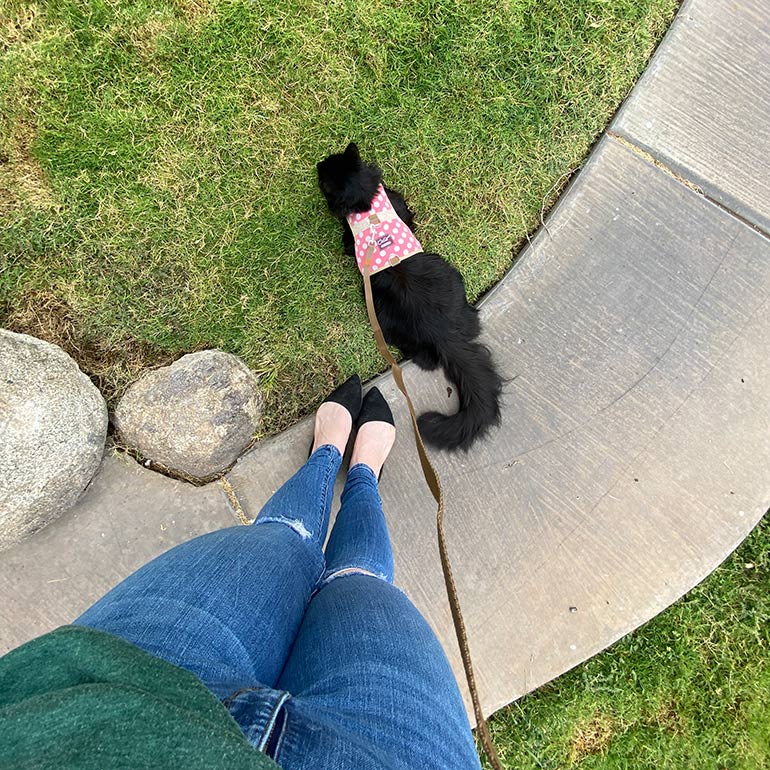Is It Easy to Train Cats to Walk on a Leash
Cats have a reputation for being natural-born homebodies. Between catnaps, couch lazing and early-morning cuddles, it's no wonder many owners think of their cats as indoor-only companions. However, some naturally crave more adventure than what your home can provide. In this case, leash training a cat may help nurture that adventurous nature.
Leash training a cat can be a great way to provide your fur baby with physical activity and mental stimulation. If you want to let your adventurous feline get their exploration on, here's everything you need to know about how to train a cat to walk on a leash.
What Is Cat Leash Training?
You're likely already familiar with the concept of walking a dog on a leash. The concept is the same here, only we're speaking specifically about how to train a cat to walk on a leash—and your cat will likely still use the litter box as their go-to bathroom spot.
"Leash training teaches cats to accept walking on a tether attached to a harness or jacket. This opens up the world to cats, so that kitty can travel beyond the house and visit other places, like the backyard, while staying safe," explains Amy Shojai, CABC, a pet behaviorist in Sherman, Texas.
Leash training a cat can sometimes require a bit more time and patience than getting a puppy used to walking on a leash, since cats are naturally quite independent creatures. With a little effort though, and by paying close attention to your kitty's cues, it can absolutely be done!
Why Leash Training a Cat Is Beneficial
While cats who live indoors are generally healthier and less at risk for injury than those who live outdoors, many kitties can benefits from exploring the outside world in a safe and controlled manner. Learning how to leash train a cat or kitten is a great way to let them stretch their boundaries, exercise their bodies and their minds and maybe discover a part of their personalities that doesn't always come out when they're behind closed doors.
Shojai believes that many cats can benefit from leash training, especially confident, active kitties and those who live in small apartments and may not have access to an enclosed patio or backyard.
"Very confident felines accept leash training more readily. Kittens, especially those under a year of age, also learn to accept leash training most easily, perhaps because they still have that kitten curiosity," she says.
Laura Moss, editor-in-chief and co-founder of AdventureCats.org, a resource for outdoorsy cat lovers, agrees. "Cats certainly love to sleep, but to stay healthy they need physical activity and mental stimulation just like we do," she explains.
Of course, not all cats are bound to love the great outdoors—and that's OK, too. Be sure to pay close attention to your feline's behavior (more on that below!) to ensure they're comfortable exploring the outside world.
What You Need for Leash Training a Cat
You'll need just a few items to begin leash training a cat: a well-fitted harness (or cat walking jacket) and a shorter leash with some slack.
Leash Training My Cat
Ever since my cat Roxie was an itty-bitty kitten, she was absolutely fascinated with the outdoors. She'd sit by the sliding glass doors in our home and paw at them wistfully, absolutely enthralled by anything that moved. Like any pet parent, I was highly protective of her, but I knew that I eventually wanted to start leash training this cat and letting her venture outdoors—here goes nothing!

"I do not recommend attaching a leash directly to the cat's collar for two reasons," Shojai is sure to note.
"First, pulling against the leash via the collar could potentially injure your cat's neck. A cat's head is about the same circumference as her neck and the feline neck is pretty fragile," she explains. "Second, a cat's collar readily comes off over the head with tugging, and your cat may become frightened and escape."
Consider a two-in-one harness and leash like the Red Dingo Classic Nylon Cat Harness & Leash. The harness is adjustable and features a safety release in case your cat gets caught in a tight spot.
The Comfort Soft Mesh Cat Harness is another option. It offers great support and evenly distributes leash pressure across your kitty's chest to prevent neck discomfort. The harness should feel snug but not too tight; you should be able to place two fingers between the harness and your cat's body.
As for leashes, Shojai recommends a shorter lead to keep your cat nearby and under more careful control. "I am not a fan of retractable leashes for any pet, as these tend to teach the pet to pull, and also can allow pets to wander too far from safety," she says.
In addition to the above equipment, also make sure your cat is up-to-date on all their vaccines, as well as their flea and tick medication. Your cat may encounter other kitties or creatures while outside, making their rabies and feline leukemia vaccines all the more important, and you'll want to ensure that they're well-protected from pesky (and dangerous!) fleas and ticks. Check out the best flea and tick treatments for cats here.
You may also want to consider microchipping your furry friend to help the two of you reunite in the event your cat manages to break free. You can learn more about pet microchips here.
How to Train a Cat to Walk on a Leash
By following the easy-enough steps below, pet parents can learn how to leash train their cat or kitten and start exploring the great outdoors together.
1. Acquaint Your Kitty with the Harness
Like anything new, you cat may need some time to get used to their harness. "Practice snapping the harness together or undoing the Velcro to get your kitty accustomed to those new sounds," suggests Moss.
If your cat seems reticent, try placing the harness and leash in their favorite spot, such as by the food bowl or on their favorite couch cushion.
2. Try Fastening It
Once your cat becomes more comfortable around the harness, try fastening it. Pay attention to your cat's cues: Any signs of discomfort or anxiety, such as pulling away or freezing in place, mean you should take it off, offer some positive reinforcement and wait a bit to try again later.
Before venturing outdoors, I practiced walking Roxie around the house with her leash and harness. She wasn't too keen on wearing it at first, but she did get used to the feeling pretty quickly. I also tried to make positive memories right away by playing with toys and giving treats inside the house while her harness was on.
"Remember, it's normal for cats to freeze up, refuse to walk or walk strangely the first few times they're wearing a harness," Moss says. "Your cat has never experienced the sensation before, so it's going to take time to adjust to it."
3. Practice Inside the House
After your cat seems more comfortable in their harness, Shojai recommends five-minute training sessions where you and your kitty practice walking on the leash and harness indoors and to encourage them with treats. Then, you can work up to longer periods of time and (finally!) start heading outside.
4. Suit Up Before Stepping Out
Once your kitty seems OK wearing the harness and leash inside, you can begin venturing outdoors. When it's time to take the plunge, be sure to put the leash and harness on before going outside. Otherwise, you risk your cat darting away sans leash, and that's definitely not the kind of adventure you want!
5. Carry Your Cat Outside
Pick up your harnessed and leashed cat before going outside instead of letting them walk out on their own.
"A cat that's used to walking outside when they're leashed will likely start walking out the door when they're not leashed as well, and you don't want to encourage door dashing," Moss warns.
6. Start Exploring (Slowly!)
Let your kitty take the lead. Some cats may be perfectly content to lie still in the grass and soak up the sun, others may want to check out the neighborhood. Some cats may also be overwhelmed by all the new sights and sounds and want to go back inside ASAP. Follow their lead and be encouraging with treats.
Shojai says, "With dogs, we tend to want them to follow us when on leash, but with cats let the kitty be the leader. Don't try to force the cat to walk or move anywhere. It's all about making the experience enjoyable for the cat."
Remember, Never Force Your Cat to Walk on a Leash
With Roxie, we stuck to the area directly around our house. That includes the front porch and around the yard. We have ventured as far as two neighbors down—that seemed like plenty of adventure for her!

Finally, take care to never force your cat to do something they're not ready to do or are uncomfortable with. If they instantly dart back inside or freeze up when you go out, you can try again in a few days to see if they gradually become more comfortable with the outside world. But if the situation doesn't improve, leash training may just not be for your kitty.
"Don't force your cat to do anything they aren't ready for, whether it's simply putting on the harness or going for a hike," Moss says. "Forcing your cat outside of their comfort zone will likely backfire and will not only frighten your cat but may also be harm your relationship."
Remember that there are plenty of ways you can bond and spend time with your favorite feline from the comfort of your own home. (Check out some here!)
Source: https://be.chewy.com/cat-walking-101-train-cat-walk-leash/